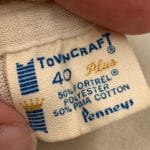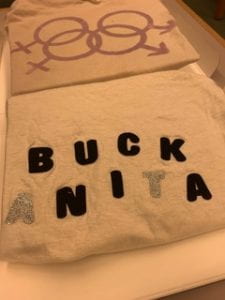Blog post by Morgan McCartan ’22
This online blog post features materials protected by the Fair Use guidelines of Section 107 of the US Copyright Act. All rights reserved to the copyright owners.
You can feel the passion and pride of those who wore and designed these t-shirts. Within the Human Sexuality Collection in Cornell University Library’s Division of Rare and Manuscript collections are three t-shirts silk screened by Cornell students in the 1970s. The three shirts each have a different design: two male and female symbols interlinked, the letters NYSCGO (New York State Council of Gay Organization), and one with a play on words “Buck Anita.” Each of these shirts, while carrying different messages, reflect the beginning of student-led LGBTQ+ activism on Cornell’s campus.

Figure 1: Silk screened t-shirt with two male and two female signs interlinked conveying bisexuality
Before analyzing the principles of design and the material properties of the t-shirts, it is critical to understand the historical context of LGBTQ+ rights on campus when these shirts were made. These shirts were created at the beginning of a long-standing tradition of political activism at Cornell regarding gender identity and sexual orientation. On May 10th of 1968, Cornell students took initiative and formed the Student Homophile League (SHL), making Cornell the second college campus in the United States to have a student gay rights group (Beemyn, 205). The movement on university campuses would lay the groundwork for a pivotal moment that would occur in New York City just a year later. Between June 27th and 29th of 1969, the Stonewall Riots broke out in Greenwich Village, where nearly 400 gay, lesbian, bi-sexual, and transgender people protested their previous treatment and pushed police out of the area surrounding the Stone Wall Inn. Voices began to be heard. Following the riots, the Gay Liberation Front and the Gay Activity Alliance were formed in New York to urge sexual liberation for all people and secure basic rights for all gay people (Teaching LGBTQ History). Back on Cornell’s campus, an Afro-American group occupied Willard Straight Hall in protest of the administration’s lack of sensitivity toward Black students regarding their mistreatment in the judicial system and the nearly absent Black studies curriculum (Beemyn, 216). The aftermath of the takeover would eventually influence the administration to re-evaluate their judicial system and make necessary changes. For the SHL, this was an eye-opening experience: a minority group had made progress against the then-prejudiced institution that was Cornell. By the beginning of 1970, the SHL had gained visibility on campus—they joined with the Students for a Democratic Society, which was large and organized, and thus had access to a printing company to start spreading awareness via flyers and newsletters (Beemyn, 218). This was presumably the time when the t-shirts in the figures below were silk screened, just before they were worn by students in NYC’s Gay Pride March on June 28th, 1970. Following the march, Cornell students would pursue a tradition of activism by forming a Cornell LGBTQ+ alumni group, establishing a Human Sexuality collection in Cornell libraries, and creating a minor in Lesbian, Bisexual & Gay (LBG) Studies (Cornell Pride). Cornell students, and these t-shirts, were an impetus toward equality not only on Cornell’s campus, but in the United States.
The messages screened on the t-shirts each hold

Figure 2: Silk screened t-shirt with the letters and symbol for NYSCGO (New York State Council of Gay Organizations)
significance. In Figure 1, the male and female symbols interlinked convey bisexuality. The lavender color represents the combination of blue, representing opposite-gender attraction (straight), and magenta, same-gender attraction (gay), thus the combination is a blend of same and opposite attraction (bi). These three colors now make up the bi-pride flag (Wilber).
In Figure 2, a symbol and lettering “NYSCGO” represent the New York State Council of Gay Organization, which was founded by the Mattachine Society, an early national gay rights organization that formed in 1950 out of the Niagara Frontier (Fifth Freedom). With their base in Buffalo, NY, it can be presumed that Cornell students found a connection with the Mattachine society based on their close geographic proximity. However, the lack of information on the NYSCGO indicates it was most likely short lived.
The last shirt showcases the slogan, or play on words, “Buck Anita,” seemingly meant to be read as “F*ck Anita Bryant.” Anita Bryant was an American singer and outspoken opponent of gay rights in the ’70s. She ran a campaign in Florida known as, “Save Our Children,” that enabled discrimination based on sexual orientation (Hall, 556). Her campaign would thankfully be denounced by gay rights activists, and so it’s likely that this particular t-shirt was created later in the 1970s when Bryant was most outspoken.
Each of these shirts, likely made on the lawn between Annabel Taylor Hall and the Law School, were drawing attention across campus. The item description from the manuscript collection states, “the t-shirt making caught the eye of the Delta Upsilon boys, a fraternity, whose house resided behind the Law School and Anabel Taylor Hall” (Cornell…Coalition Records).
Why t-shirts? Well, t-shirts have had a long-standing history in activist fashion. The t-shirts were the brand “Towncraft,” shown in Figure 4, and were made of 50% Fortrel polyester and 50% pima cotton. The common “Fruit of Loom” undershirts are made of this same blend of Fortrel polyester and cotton. This simple, inexpensive, light-colored, and jersey-knit shirt became the perfect medium for college students to silk screen political messages. The students most likely used a hand stencil on the silk screen and applied plastisol or water-based ink through the mesh screen, or, in the case of Figure 3,

Figure 4: Tag from the t-shirts used in Figures 1-3. The brand is Towncraft and the material is a polyester and cotton blend.
attached iron-on flocked letters. The colors of the symbols and letters contrast against the light background, creating emphasis. Cornell students had mastered the “human billboard,” and found a way to advertise, advocate, and articulate important messages surrounding LGBTQ+ rights through fashion.
Fun fact: Towncraft undershirts/t-shirts have become extremely rare and sought after since their production discontinued. They are known for their “comfiness” and are only found for purchase from secondhand sources such as Ebay and Mercari.
References
Beemyn, Brett. “The Silence Is Broken: A History of the First Lesbian, Gay, and Bisexual College Student Groups.” Journal of the History of Sexuality, vol. 12, no. 2, University of Texas Press, 2003, pp. 205–23, http://www.jstor.org/stable/3704612.
Cornell Lesbian, Gay, Bisexual, and Transgender Coalition records, #37-6-1589. Division of Rare and Manuscript Collections, Cornell University Library.
“Fifth Freedom, 1983-12-01.” The Mattachine Society of the Niagara Frontier. The Dr. Madeline Davis LGBTQ Archive of Western New York. Archives & Special Collections Department, E. H. Butler Library, SUNY Buffalo State. https://digitalcommons.buffalostate.edu/fifthfreedom/87.
Hall, Simon. “The American Gay Rights Movement and Patriotic Protest.” Journal of the History of Sexuality, vol. 19, no. 3, University of Texas Press, 2010, pp. 536–62, http://www.jstor.org/stable/40986338.
“History of Cornell Pride.” Cornell Pride – History, https://cornelluniversity.imodules.com/s/1717/cc/club.aspx?sid=1717&gid=60&pgid=2701.
“LGBTQ Rights Timeline in American History ” Teaching LGBTQ History.” Teaching LGBTQ History, https://www.lgbtqhistory.org/lgbt-rights-timeline-in-american-history/.
Wilber, Jennifer. “Show Your True Colors: A Guide to Bi Pride Symbols.” Owlcation, Owlcation, 19 June 2018, https://owlcation.com/humanities/Show-Your-True-Colors-A-Guide-to-Bi-Pride-Symbols.

